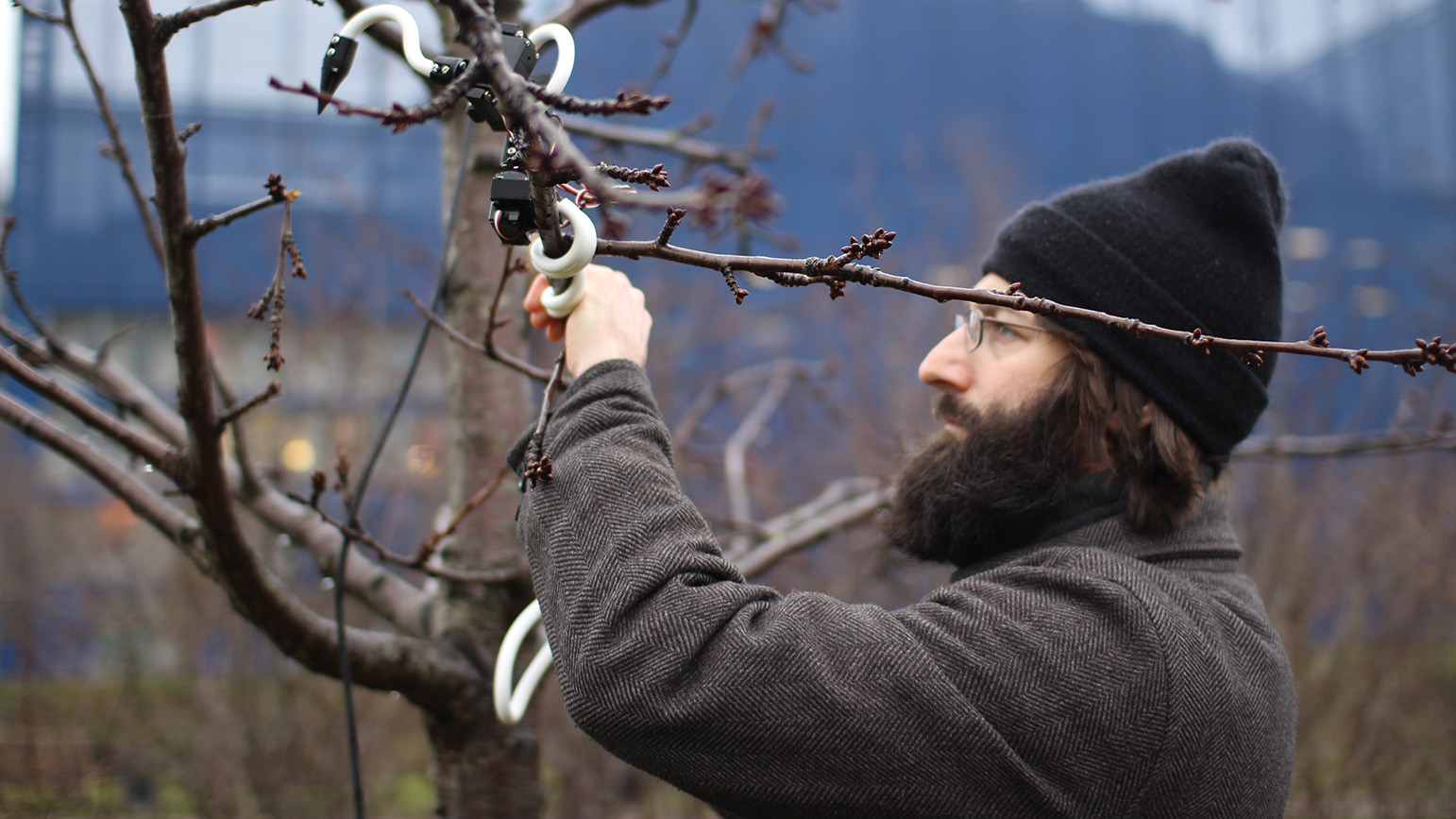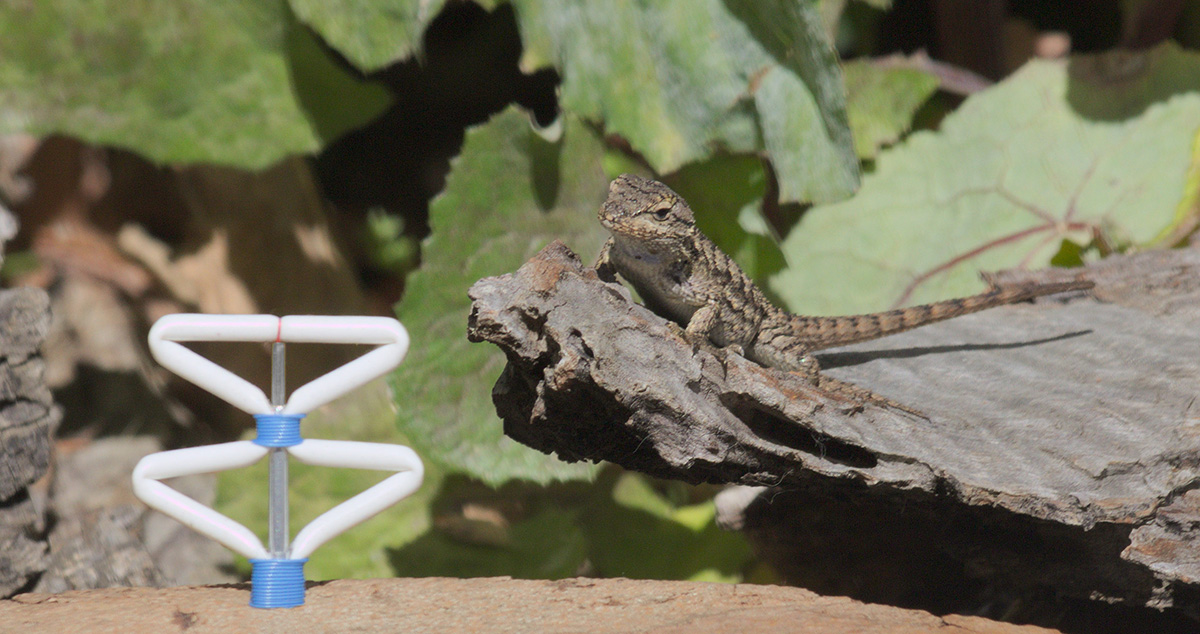
“5 Questions” is an ongoing series with School of Art alumni who are transforming art, culture, and technology, exploring their creative practices, career milestones, and Carnegie Mellon memories.
Ian Ingram creates robots in order to investigate the nature of communication between humans and non-human animals. His robotic systems — in scale, form, behavior and gesture — make signals that are meaningful to the non-human species but often in a playful human-like narrative context. The robots use computer vision or sound signal processing to search the world for the signals of target species and then attempt to respond through similar gestural and audible signalling.
After obtaining a BS in Ocean Engineering and an MS in Ocean Acoustics from MIT, Ingram earned his MFA at CMU. His work has been exhibited internationally including at Ars Electronica (Linz, Austria); the Museum of Modern Art (Toluca, Mexico); Yada Gallery (Nagoya, Japan); the Victoria and Albert Museum (London, U.K.); and at The Andy Warhol Museum (Pittsburgh), among others. He currently has a solo exhibition at the Beall Center for Art + Technology at the University of California Irvine through March 5.
1
How do you use robots to create pathways of communication between humans and non-human animals?
Many of my robots use signals that are salient to animals other than ourselves because they are those animals’ own signals. For species like the western fence lizard, the common raven, and the eastern gray squirrel, I have used gestural signals: tail flicks, beak wipes, head bobs. With some, like the pileated woodpecker, I have used audible signals, although still brought about from mechano-gestural interaction with the environment, not with speakers. Many of my robots are sending messages coded in multiple, sometimes overlapping, ways. For instance, in “Nobody Told the Woodpeckers,” the robot listens for the territorial drumming of Pileated and Black Woodpeckers which are closely related species that anthropogenic climate change might allow to meet each other for the first time since they split millions of years ago. The robot then translates the drumming it heard for the benefit of the second species, hopefully preventing a communication crisis complicating the territorial dispute. At that point, it proceeds in Morse Code to tap out an explanation of anthropogenic climate change to get the woodpeckers up to speed on what is going on. But, almost without a doubt, the woodpeckers are not going to understand that part of the message.
2
We often think of technology as removing humans further from the natural world. How does your use of robots help us to examine our place within the natural environment?
There is also the stance that drawing a distinction between the natural and the artificial represents a false dichotomy. And the fact that the human hand is deeply embedded in every ecosystem on the planet at this stage of our presence on it (even where we pretend it isn’t). But I think there is some utility in having terms and concepts for that which proceeds without our intervention and that which originates from us, even as they are now so interwoven.
So my robots are both intermediaries between ourselves and the rest of the natural world and embodied questions about the degree to which our artifacts are truly foreign in that world. They are also new bodies that don’t have to grow, don’t have to come from forms brought about by millions of years of evolution but do simultaneously inherit from those forms. They allow for the kind of communion people, including myself, want to have with other animals that is often impossible because of our own bodies and perception systems. Via machine-learning-backed perception systems and shapes and gestures that other animals understand, they thus facilitate a kind of interspecies communication. This inherits from an age-old tradition. The robot is both ancient human goal and contemporary human technology. Our ancestors were making robots when they painted the walls in Lascaux and even then they were seemingly motivated by a desire to understand their place in the world.

3
Tell us about how you use humor to explore more serious subjects.
Humor and play are pathways to a receptive state of mind. They can also be tools to alleviate the exhaustion of living in a collapsing world. We are all, of course, collectively trying to find solutions to these seemingly intractable problems we face as a species and humor can be a soft lure to attract tapped-out people back to this effort and similarly a gateway to engage people who haven’t yet come to realize the severity of the crisis.
We human beings also tend to tell stories about animals and there is something basically funny about the abject fallaciousness of many, many of these stories. It is often these kinds of stories that I wrap into my projects so some of the humor comes from there. Moreover, I think some of it grows from the built-in absurdity of our collective casual acceptance of technology as an indubitable good, which is both a tool and a subject in my work.
4
Could you talk a bit about your time as a grad student at CMU’s School of Art? Are there any experiences you had as a student that stand out?
It was such a glorious three years and then, of course, another glorious few years of teaching as an adjunct while I was working at the Robotics Institute on Robot250 and related projects. As folks there may remember, I kept trying to figure out ways to stay in Pittsburgh forever!
While a student, I had a particular focus on Schenley Park and a number of my robots were in essence site-specific works for little places within the park. Tree Hugger—which slowly raked a circle of leaves around the tree from which they had fallen—was originally built for a particular tree in Schenley. On Beyond Duckling was originally built for Westinghouse Pond.
Bob Bingham and I went down to that pond one day with On Beyond Duckling to watch it perform its forlorn, unrequited mating dance. The actual ducks give the robot a wide berth but the ornamental carp in the pond always seemed a little interested in its unusual maneuvers. That day with Bob, a blob of the carp unraveled into a string of fish as the robot rowed to the center of the pond. And as it began its dance, the fish formed into an orange Fibonacci spiral around it. Just as the lead fish at the center of the spiral reached the robot and seemed to kiss one of its eggshell pontoons, the robot stroked its back with its feathered oar, and the fish scattered like a firework. It felt as if something had been unlocked in the world and that moment has been on my mind ever since.

5
Do you have any advice to share with students?
Advice is a funny thing. A professor at CMU who is a friend and mentor and who helped me in many ways over the years also once gave me what amounted to terrible advice. For me. I asked them for guidance on how to succeed as an artist and specifically on how they had succeeded as an artist and they said (as I remember it) “I just kept making things. You gotta just keep making things.” For them, in that moment, it might have seemed like good advice and for many students maybe it would have been perfect guidance. But another important side of the equation which I was and am particularly bad at is that you have to learn how to promote your work, and do it. The professor I am talking about was and is brilliant at promoting their work so when I finally figured out the importance of promotion, I realized that was more of what I should have captured from their wisdom and experience. I think they guided me in that direction at other times — even once stopping me as I was introducing myself in a meeting a number of years later to re-introduce me when they felt I was burying the lede — but again advice is a funny thing and whether it is any good has to do with timing and the receiver’s state of receptivity. So, yes, keep making work. And promote it!




